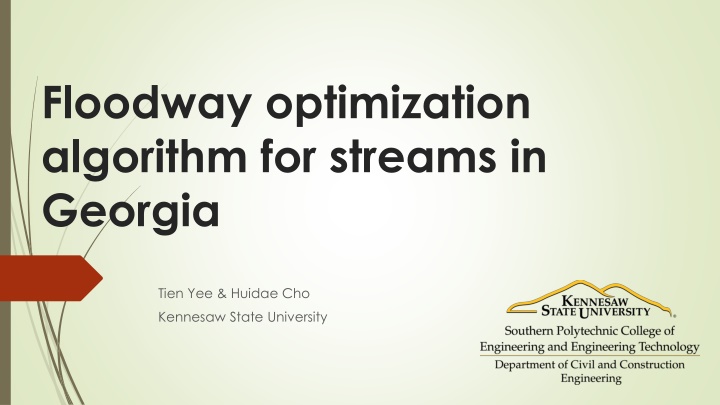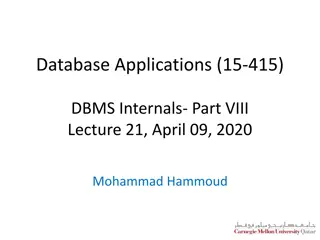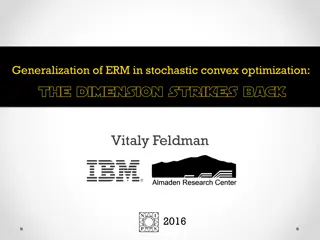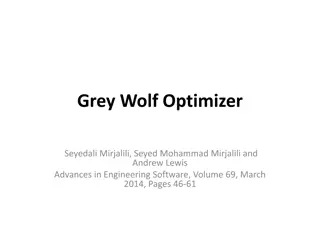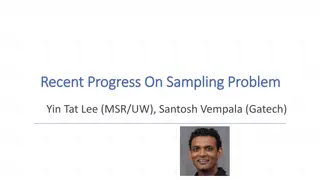Optimization Algorithm for Floodway Management
This research project delves into a novel floodway optimization algorithm for streams in Georgia, developed by Tien Yee and Huidae Cho from Kennesaw State University. The algorithm aims to streamline floodway modeling and management, offering insights into FEMA standards, typical criteria, traditional floodway creation methods, and the ISPSO optimization approach coupled with HEC-RAS software. The workflow involves initializing, evaluating, evolving, and interacting with HEC-RAS outputs. The motivation behind the study is to produce efficient floodways with minimal area coverage, catered towards unbiased and practical implementations.
Uploaded on Feb 22, 2025 | 1 Views
Download Presentation

Please find below an Image/Link to download the presentation.
The content on the website is provided AS IS for your information and personal use only. It may not be sold, licensed, or shared on other websites without obtaining consent from the author.If you encounter any issues during the download, it is possible that the publisher has removed the file from their server.
You are allowed to download the files provided on this website for personal or commercial use, subject to the condition that they are used lawfully. All files are the property of their respective owners.
The content on the website is provided AS IS for your information and personal use only. It may not be sold, licensed, or shared on other websites without obtaining consent from the author.
E N D
Presentation Transcript
Floodway optimization algorithm for streams in Georgia Tien Yee & Huidae Cho Kennesaw State University
FEMA & Floodway Typical standard hydraulic modeling software acceptable by FEMA HEC-RAS. Floodplain model good guideline Floodway model not much guidelines/details Potential problems: Permitting construction Economic interest Depends on floodway boundary Etc.
Typical criteria Criteria Surcharge between 0 to 1 ft Encroachments limits- between floodplain limits and channel banks Froude number < 1 (typical for stream in GA)
Traditional floodway creation Encroachment Interdependent between cross sections difficult and non-linear Typical process:- Floodways Manual procedure- Trial and error Meet all mentioned criteria May not be optimized In-house computer models may not be acceptable by FEMA
Motivation Motivation: Produce floodway with reach-wide minimal area Couple optimization with HEC-RAS Unbiased & practical
Optimization - ISPSO (Isolated-Speciation- based Particle Swarm Optimization) ISPSO - New optimization method based on Species-based PSO (SPSO) Implemented in R-language Local and global optimum ISPSO -Many different applications Hydrologic & Hydraulic modeling Stochastic rainfall modeling Uncertainty Heuristic optimization model > HEC-RAS
Optimization & HEC-RAS Source code HEC-RAS Not easily available Workaround => Optimization main, HEC-RAS submodel
Workflow Optimization Model Initialize Evaluate Evolve Input HEC-RAS Input 1 Input 2 Input 3 Input n User/Engineer Output HEC-RAS Output 1 Output 2 Output 3 Output n
Objective function ??? ???????? ?( ?, ?) = ???_????? Where, Afw = Ai - Amin Afw_range= Amax - Amin
Advantageous Automates floodway limits Minimizes area Based on constraints Compatible with HEC-RAS(standard hydraulic model)
Test runs Two test cases: Hale Tributary Lilburn, GA Redland Creek Lawrenceville, GA Downloaded from flood risk information website 02/01/2017 http://gwinnettfloodplain.com/ Original floodplain model violated some constraints Test for 1. Ability to optimize Floodway 2. Capability to automate process 3. Visual comparison effective vs. optimized floodways
Results Hale Trib Culvert 3 Culvert 2 Culvert 1 Culvert
Results Redland Creek Bridge Culvert
Results Footprint optimized > Effective models Direct comparison Not possible Program attempt to balance Minimizing area Ensure FR < 1 Ensure Surcharge within constraints
Other tests Prairie Brook Prairie Brook in Helena, Alabama Effective model no issues Simple model
Prairie Brook Culvert
Surcharge (ft) Froude # XS River Sta 7592.8 7114.3 6828.2 6315.2 5711.9 5157.3 4684.4 4290.3 3704.9 3664.9 3617.9 3562.3 3494.7 3454 3414.5 2881.6 2466.3 2446.7 2423.8 1880.6 905.6 657.8 509.2 438.2 215.3 Effective Optimized Effective Optimized 0.5 0.13 0.69 0.48 1 0.87 0.69 0.95 1 0.93 0.88 0.85 0.69 0.58 1.02 0.99 1.02 0.95 Culvert 1.02 0.94 1.01 0.94 0.94 0.94 Culvert 0.98 0.98 0.99 0.93 0.99 0.89 Culvert 0.99 0.86 0.99 0.87 1 0.8 1 0.82 Culvert 0.03 0.31 0.27 0.27 0.83 0.29 0.47 0.27 0.45 0.32 0.48 0.14 0.05 0.99 0.3 0.44 0.22 0.56 0.28 0.52 0.14 0.06 Promising results Footprint area smaller than effective model Meets all constraints 0.05 0.09 0.22 0.08 0.08 0.18 0.14 0.06 0.06 0.12 0.09 0.08 0.05 0.04 0.03 0.07 0.1 0.04 0.1 0.07 1.11 0.33 0.7 0.33
Limitations 1. Jagged (undulating) floodway 2. Supercritical flows in floodplain models 3. Computation time
Conclusion Model is still under development still needing many improvements Model is capable of minimize floodway footprint No user intervention process encroachment extents
How you can help & contribute We are currently seeking good hydraulic models for testing Welcome ideas & collaboration from individuals or organizations
Thank you. Questions?
